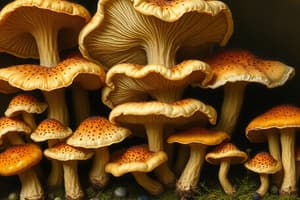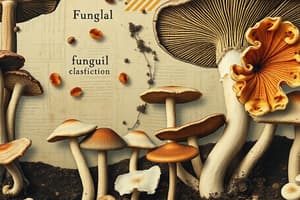Podcast
Questions and Answers
Fungi are classified into groups by their:
Fungi are classified into groups by their:
- Size
- Spore producing structures (correct)
- Habitat
- Color
Fungi that break down complex organic substances into raw materials that other organisms can use are called?
Fungi that break down complex organic substances into raw materials that other organisms can use are called?
decomposers
In hyphae divided by septa, cytoplasm flows from one cell to the next through?
In hyphae divided by septa, cytoplasm flows from one cell to the next through?
pores
Yeasts usually reproduce asexually by?
Yeasts usually reproduce asexually by?
The bread mold Rhizopus produces sexual zygospores when?
The bread mold Rhizopus produces sexual zygospores when?
Fossils of fungi are rare due to fungi's?
Fossils of fungi are rare due to fungi's?
In parasitic fungi, specialized hyphae that penetrate cells and absorb nutrients are called?
In parasitic fungi, specialized hyphae that penetrate cells and absorb nutrients are called?
A case in which asexual spores are produced is called?
A case in which asexual spores are produced is called?
A thick-walled spore adapted to withstand unfavorable conditions is called?
A thick-walled spore adapted to withstand unfavorable conditions is called?
Hyphae that grow horizontally along the surface of a food source are called?
Hyphae that grow horizontally along the surface of a food source are called?
The complex carbohydrate in the cell walls of fungi is called?
The complex carbohydrate in the cell walls of fungi is called?
A mutualistic association between a fungus and a green alga or cyanobacterium is called?
A mutualistic association between a fungus and a green alga or cyanobacterium is called?
The saclike structure in which sexual spores develop in some fungi is called?
The saclike structure in which sexual spores develop in some fungi is called?
A spore produced by sac fungi is called?
A spore produced by sac fungi is called?
A mutualistic association in which a fungus lives in close contact with the roots of a plant partner is called?
A mutualistic association in which a fungus lives in close contact with the roots of a plant partner is called?
In zygomycetes, the haploid structures that fuse to form a diploid structure are called?
In zygomycetes, the haploid structures that fuse to form a diploid structure are called?
Fungal hyphae form a network of filaments called a?
Fungal hyphae form a network of filaments called a?
The cell walls of fungi are composed primarily of?
The cell walls of fungi are composed primarily of?
Which describes the feeding behavior of fungi that feed on dead organic matter?
Which describes the feeding behavior of fungi that feed on dead organic matter?
Parasitic fungi have developed specialized hyphae that penetrate host cells; these hyphae are called?
Parasitic fungi have developed specialized hyphae that penetrate host cells; these hyphae are called?
What type of hyphae grows horizontally along a surface in order to produce a mycelium?
What type of hyphae grows horizontally along a surface in order to produce a mycelium?
Which of the following is formed when Rhizopus reproduces sexually?
Which of the following is formed when Rhizopus reproduces sexually?
Ascomycetes, called sac fungi, reproduce both sexually and asexually. Asexual spores of ascomycetes are called?
Ascomycetes, called sac fungi, reproduce both sexually and asexually. Asexual spores of ascomycetes are called?
The undersides of some mushrooms have gills that are lined with which of the following?
The undersides of some mushrooms have gills that are lined with which of the following?
An example of a deuteromycete is?
An example of a deuteromycete is?
A mycorrhiza is a mutualistic relationship between a fungus and a?
A mycorrhiza is a mutualistic relationship between a fungus and a?
An antibiotic produced by a deuteromycete is?
An antibiotic produced by a deuteromycete is?
Plants that have ___ associated with their roots grow larger.
Plants that have ___ associated with their roots grow larger.
Make up a division of fungi that have no known sexual stage?
Make up a division of fungi that have no known sexual stage?
A lichen is a mutualistic relationship between a fungus and a ___ or cyanobacterium.
A lichen is a mutualistic relationship between a fungus and a ___ or cyanobacterium.
Lichens are ___ in all parts of the world.
Lichens are ___ in all parts of the world.
Scientists think that ascomycetes and ___ evolved from a common ancestor.
Scientists think that ascomycetes and ___ evolved from a common ancestor.
What is the purpose of the additive calcium propionate in bread?
What is the purpose of the additive calcium propionate in bread?
Fungi are classified mainly by means of what?
Fungi are classified mainly by means of what?
How do parasitic fungi obtain their food?
How do parasitic fungi obtain their food?
Fungi in this phylum do not undergo asexual reproduction.
Fungi in this phylum do not undergo asexual reproduction.
Mushrooms belong to this phylum.
Mushrooms belong to this phylum.
These fungi are closely related to plant-like protists.
These fungi are closely related to plant-like protists.
Largest phylum of fungi.
Largest phylum of fungi.
Common molds that grow on cheese and bread are members of this phylum.
Common molds that grow on cheese and bread are members of this phylum.
This is the only group of fungi that produce motile spores.
This is the only group of fungi that produce motile spores.
Rhizoids and stolons characterize these fungi.
Rhizoids and stolons characterize these fungi.
Yeasts are members of this phylum.
Yeasts are members of this phylum.
Study Notes
Fungi Classification and Structure
- Fungi are categorized by their spore-producing structures.
- Hyphae divided by septa allow cytoplasm to flow through specialized structures called pores.
- Fungal cell walls primarily consist of chitin, a complex carbohydrate.
Fungal Reproduction
- Yeasts typically reproduce asexually via budding.
- Rhizopus, a bread mold, produces sexual zygospores in the presence of moist food.
- Asexual spores of ascomycetes are known as conidiophores.
- Zygospores are the result of sexual reproduction in Rhizopus.
Fungi Types and Functions
- Decomposers break down complex organic materials, returning raw nutrients to the ecosystem.
- Parasitic fungi utilize haustoria to invade host cells and absorb nutrients.
- Mycorrhizae represent a mutualistic association between fungi and plant roots.
- Lichens are mutualistic relationships between fungi and algae or cyanobacteria, serving as pioneer species.
Fungi Morphology
- Mycelium is made up of a network of filamentous hyphae.
- Stolons are hyphae that grow horizontally over food sources.
- Both rhizoids and stolons characterize basidiomycota.
- Sporangium is the case in which asexual spores are produced.
Specialized Structures
- Haustoria penetrate host cells in parasitic fungi to obtain food.
- Ascus is a sac-like structure where sexual spores develop in some fungi.
- Zygospores are thick-walled spores that endure unfavorable conditions.
Phylum Characteristics
- Ascomycota, the largest phylum, includes fungi closely related to plant-like protists.
- Basidiomycota includes mushrooms and fungi characterized by basidia found on gills.
- Deuteromycota, or imperfect fungi, lack a known sexual reproduction phase.
- Oomycota are unique for producing motile spores.
Ecological and Practical Applications
- Fungi play essential roles in ecosystems as decomposers and symbionts.
- Penicillium, a type of deuteromycote, produces the antibiotic penicillin.
- Calcium propionate is an additive used in bread to extend shelf life.
Evolutionary Insights
- Ascomycetes and basidiomycetes are believed to have evolved from a common ancestor.
Studying That Suits You
Use AI to generate personalized quizzes and flashcards to suit your learning preferences.
Description
Test your knowledge on the classification, structure, and functions of fungi. This quiz covers key concepts such as fungal reproduction, types of fungi, and their ecological roles. Perfect for students studying mycology or related biological sciences.





